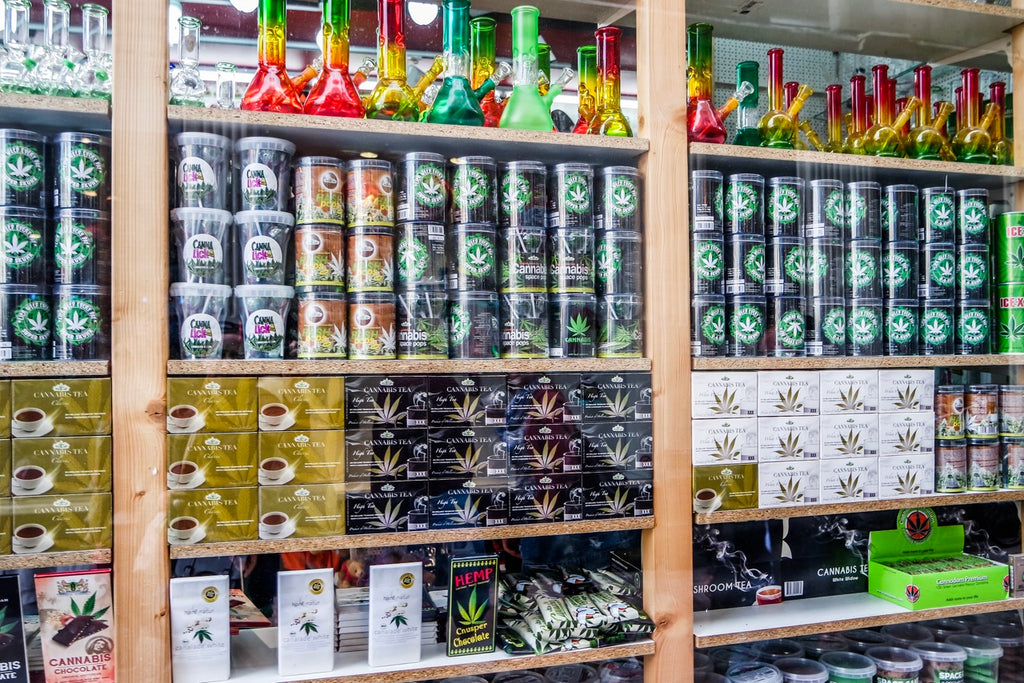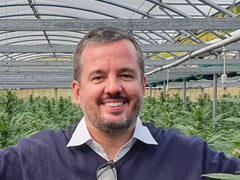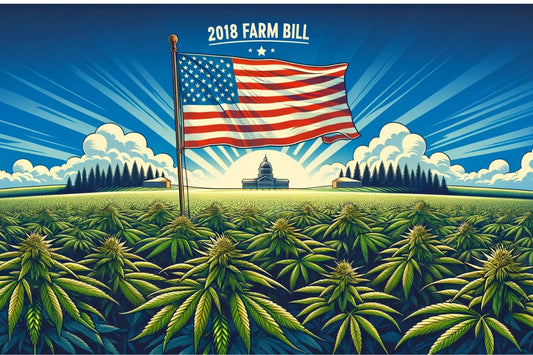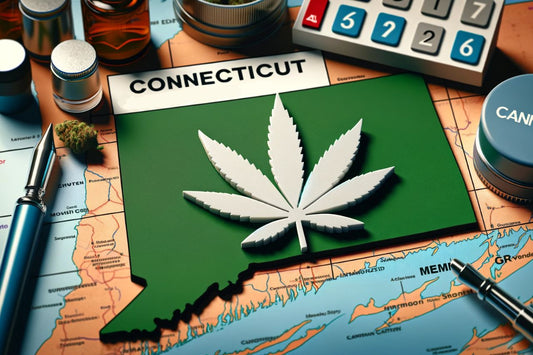THC, or Tetrahydrocannabinol, is the principal psychoactive compound found in the cannabis plant, responsible for inducing the sensation of being 'high.' As you explore the world of cannabis, whether for medicinal or recreational purposes, understanding the role of THC is crucial.
However, keep in mind that THC is only one of over 100 cannabinoids identified within the complex biochemical make-up of the marijuana plant.
Key Takeaways
- THC is the primary psychoactive compound in the cannabis plant, inducing the 'high' sensation.
- It is one of over 100 cannabinoids present within cannabis and marijuana, highlighting the plant's complexity.
- THC's effects include mood alterations, impaired memory and motor skills, and altered sense of time.
- There are potential therapeutic benefits of THC and medical benefits, including analgesia, antiemesis, and neuroprotection.
- Dosing and administration of THC require careful consideration due to its potency and psychoactive effects.
- Research and future trends involve exploring its broader therapeutic applications and potential pharmacogenomic interactions.
Introduction to THC
The story of THC discovery begins in the 1960s when the compound was first isolated and synthesised. This groundbreaking achievement accelerated our understanding of the psychoactive effects of cannabis plants and paved the way for decades of research into the properties and potential applications of this prominent cannabinoid.
Background and Discovery
Israeli scientist Dr. Raphael Mechoulam first isolated THC in 1964, revolutionising the way researchers viewed and studied cannabis plants. This marked a critical advancement in decoding the cannabinoids responsible for the 'high' sensation individuals experience when using cannabis.
Since then, THC has been a primary focus for researchers investigating both its psychoactive and therapeutic effects.
The past few decades have witnessed significant strides in understanding the complexities of THC and its interactions with the human body, altering mood, perception, and physiological processes. These discoveries have fuelled ongoing research into how THC can be harnessed for potential medical applications.
The Chemical Structure of THC
THC, scientifically known as delta-9-tetrahydrocannabinol, is unique in its molecular composition. The compound's chemical structure gives it a high affinity for the brain's CB1 receptors, accounting for the ensuing psychoactive effects. When THC interacts with the endogenous cannabinoid system, a series of events unfolds, compromising mood, perception, and various physiological processes.

"The chemical structure of THC enables it to bind powerfully to the brain's CB1 receptors, triggering the psychoactive effects characteristic of cannabis."
Comparing THC with Other Cannabinoids
Among the vast array of known cannabinoids, THC and CBD (cannabidiol) have garnered the most attention in the scientific and medical communities. The following table contrasts the primary properties of these two distinct compounds:
| Property | THC | CBD |
|---|---|---|
| Psychoactivity | Yes | No |
| CB1 Receptor Affinity | High | Low |
| Mood and Perception Alteration | Significant | Minimal |
| Primary Therapeutic Applications | Pain relief, antiemesis, appetite stimulation | Anticonvulsant, anti-inflammatory, anxiolytic |
consult a certified medical professional for guidance on the appropriate THC dosage and administration based on your specific needs and medical conditions.
For the synthetic THC preparations, nabilone and dronabinol, specific dosage guidelines are provided along with instructions on timing, especially around chemotherapy sessions for patients undergoing cancer treatment.
| Drug | Available Dosages | Common Starting Dose | Administration Notes |
|---|---|---|---|
| Nabilone | 1 mg and 2 mg capsules | 1-2 mg per day (total daily dose) | Take 1-3 hours before chemotherapy and repeated twice daily as needed |
| Dronabinol | 2.5 mg, 5 mg, and 10 mg capsules | 2.5-10 mg per day (total daily dose) | Take 1-3 hours before chemotherapy, and every 2-4 hours thereafter (up to 6 doses per day) |
Potential Benefits of THC

Despite being synonymous with the psychoactive effects of cannabis, THC boasts a range of significant therapeutic benefits. Once integrated within a purposeful cannabinoid therapy regimen, THC is known to deliver analgesic, antiemetic, and neuroprotective properties. However, responsible and regulated clinical use is essential to mitigate the risks associated with its psychoactivity and potential adverse effects.
"Strategically implemented cannabinoid therapy has the potential to unlock notable benefits of THC, transcending the compound's psychoactive reputation."
Therapeutic Effects of THC Use
- Analgesic properties - THC can act as an effective pain reliever, addressing various forms of discomfort ranging from mild headaches to debilitating chronic pain.
- Antiemetic effects - By mitigating symptoms such as nausea and vomiting, THC can be administered to patients undergoing chemotherapy to significantly improve their quality of life.
- Neuroprotection - Emerging research indicates THC's potential to safeguard the brain from degenerative processes and trauma, highlighting its prospective use within the realm of neurology.
While this list is not exhaustive, it showcases some of the numerous therapeutic applications of THC. As such, cannabinoid therapy can be tailor-made to address specific ailments, fostering a more personalised approach to medicinal marijuana use.
Clinical Use
Embracing the therapeutic potential of THC hinges upon thorough and regulated clinical implementation. For optimal efficacy, the following considerations should be of paramount importance:
- Prescribing appropriate THC dosages to balance therapeutic outcomes with the risks of psychoactivity.
- Evaluating each patient's medical history and symptoms to determine the ideal treatment plan.
- Recognising possible contraindications or interactions with other medications.
- Monitoring patient response and adjusting the cannabinoid therapy accordingly.
Adopting responsible and informed administration practices safeguards patient well-being while unlocking the full spectrum of benefits associated with THC use.
Methods of Using THC
There are various ways to use THC, catering to individual preferences and purposes. Each method offers unique experiences and effects, with factors such as onset time, duration, and intensity playing essential roles in determining the most suitable approach. We have highlighted some common THC using methods below:
- Smoking
- Vaporising
- Edibles
- Oils and Tinctures
- Capsules and Pills

Understanding these methods can help you decide the most suitable way to use THC, allowing for an informed and tailored experience.
Choosing the right THC use method depends on personal preference, desired effects, and medical or recreational intentions.
Let's dive into the specifics of each using method:
| Method | Onset Time | Duration | Intensity |
|---|---|---|---|
| Smoking | Within minutes | 2-3 hours | High |
| Vaporising | Within minutes | 2-3 hours | High |
| Edibles | 30 minutes - 2 hours | 4-8 hours | Variable |
| Oils and Tinctures | 15-45 minutes | 4-8 hours | Medium |
| Capsules and Pills | 30 minutes - 2 hours | 4-8 hours | Medium |
While smoking remains the most well-known method, alternative options offer diverse experiences for both recreational and medicinal users. Vaporising provides a smoke-free alternative, whereas edibles present a discreet and longer-lasting experience. Oils, tinctures, and capsules allow for a controlled and precise dosage, especially for individuals seeking THC treatment for specific medical conditions.
Ultimately, the choice of cannabis ingestion method hinges on personal preference, desired effects, and individual intentions, whether recreational or medicinal. Being informed about these methods will allow for a safer and more enjoyable experience when using THC.
The Adverse Effects of THC

While the therapeutic potential of THC has been recognised for various medical conditions, it is essential to be aware of the possible adverse effects and risks associated with its use.
The side effects of THC can be both psychological and physiological in nature, and their severity varies depending on the individual and their level of exposure to the psychoactive compound.
One of the primary negative impacts of THC on mental well-being is the potential for inducing anxiety and paranoia, particularly in individuals predisposed to these conditions.
The feeling of heightened alertness and worry can lead to panic attacks and significantly impair daily functioning. Additionally, THC can cause temporary impairments in cognitive functioning, including:
- Short-term memory loss
- Difficulty concentrating
- Decreased problem-solving abilities
- Impaired motor skills and coordination
In some cases, the psychological effects of THC can also include distorted sensory perceptions, such as hallucinations and delusions. These effects may be more common in individuals with a history of mental health disorders, especially when using high doses of THC.
to remove solvents used during extraction.The final product is a high-quality, pharmaceutical-grade THC that can be further processed for use in various medical treatments and formulations.
| Extraction Method | Pros | Cons |
|---|---|---|
| CO2 Extraction | Clean, efficient, high-quality result | Requires specialised equipment, can be expensive |
| Solvent Extraction | Relatively simple process, inexpensive | May require additional purification to remove residual solvents |
| Steam Distillation | No solvents needed, scalable process | Lower efficiency, potential for heat damage |
| Cold Press Extraction | Minimal impact on compounds, no residual solvents | Lower yield, may require further purification |
The Future of THC
As the landscape of cannabinoid research continues to evolve, so does the potential for unlocking further therapeutic applications of THC.
Upcoming trends and developments in the field include a wider range of medicinal uses, a deeper understanding of pharmacogenomic interactions, and a progression in legal regulations that could ultimately lead to increased accessibility and acceptance of THC-based treatments.
Investigations into the broader therapeutic potential of THC may uncover novel indications for its application, broadening the scope of conditions that can benefit from its unique properties.
Alongside these discoveries, researchers are delving into the intricacies of pharmacogenomic interactions, which involve understanding the individual's genetic response to THC and tailoring treatment accordingly. This personalised approach may optimise the therapeutic impact while minimising unwanted side effects and adverse reactions.
Legal developments in many parts of the world are gradually shifting towards a more accepting stance on THC and its medical potential, with several countries altering their regulations in favour of allowing access to cannabinoid-based treatments.
These advancements provide hope for both patients and researchers alike, as they signal a more profound recognition of the latent opportunities within the realm of cannabinoid science.
Frequently Asked Questions
What is THC?
THC, scientifically known as tetrahydrocannabinol, is the primary psychoactive compound found in cannabis plants. It interacts with receptors in the brain and nervous system, producing the characteristic euphoric sensation often referred to as the "high."
Does THC have any medical benefits?
Yes, THC has exhibited various therapeutic properties. It's known to alleviate pain by affecting neurotransmitters, reduce nausea and vomiting in certain medical conditions, and stimulate appetite, particularly beneficial for individuals undergoing treatments like chemotherapy.
What are the side effects of THC?
The side effects associated with THC use can include dry mouth due to reduced saliva production, heightened heart rate, temporary redness in the eyes, impaired short-term memory and concentration, and for some individuals, heightened anxiety or paranoia.
How long does THC stay in your system?
THC's duration in the body can last up to 30 days, contingent upon several factors including frequency of use, dosage, metabolism rate, and the type of test used to detect it in bodily fluids.
Is THC addictive?
Yes, THC has addictive potential, especially with frequent and heavy use. It can influence the brain's reward system, leading to dependence and withdrawal symptoms upon cessation.
Can you overdose on THC?
While overdosing on THC to the point of fatality is highly unlikely, using excessive amounts can induce intense and uncomfortable symptoms such as severe anxiety, paranoia, and hallucinations, which can be distressing but typically subside without causing long-term harm.
What is the difference between THC and CBD?
THC and CBD are both compounds found in cannabis, but THC is psychoactive, altering perception and cognition, whereas CBD is non-psychoactive and is recognized for its potential therapeutic effects without inducing a "high."
How is THC be used?
THC can be used through various methods including smoking dried flowers or concentrates, vaping oils or extracts, ingesting edibles like cookies or gummies, using tinctures or sprays, and applying topicals such as creams or lotions.
Is THC legal?
The legality of THC is subject to varying regulations across different regions, with some permitting its use for medicinal and/or recreational purposes while others maintain strict prohibitions.
Can THC show up on a drug test?
Yes, THC can be detected in drug screenings for a considerable duration after use, potentially showing up in urine, blood, saliva, or hair tests, depending on the timeframe and sensitivity of the test employed.










